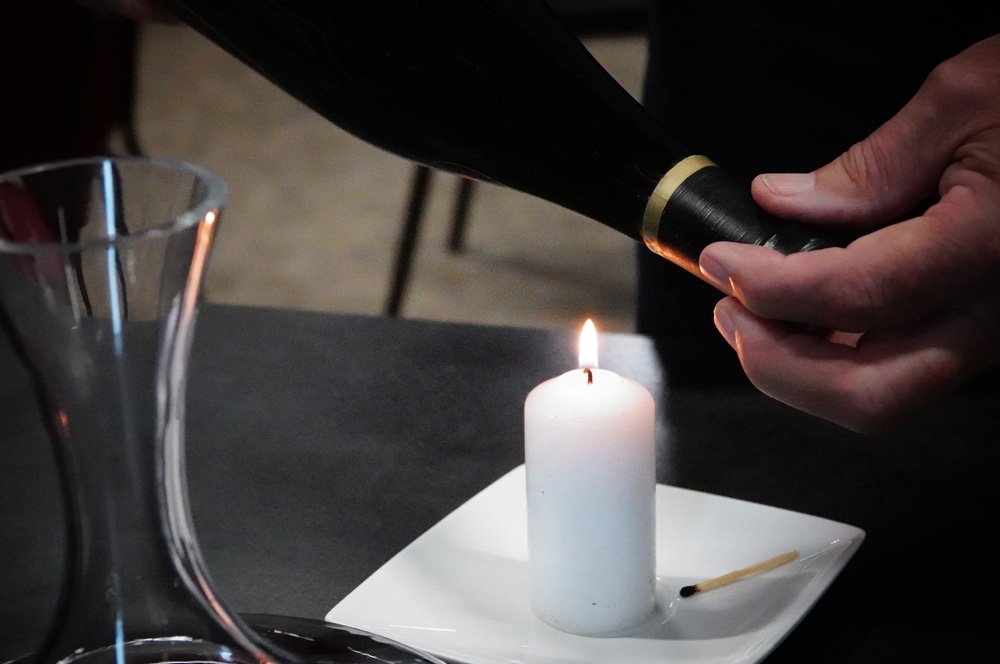Decanting a wine isn’t just an elegant gesture. It’s a simple action, but it can change the
1. Remove sediment
Some wines, especially aged or unfiltered reds, form sediment at the bottom of the bottle. These natural deposits are not dangerous, but they are unpleasant on the palate.
By gently decanting the wine into a carafe, the sediment is left in the bottle. The result is a clearer wine whose texture will not be altered when tasted. At the same time, the wine is oxygenated. This air supply is beneficial in most cases, but can prove problematic in some. The older the wine, the more fragile it is. Decanting time must therefore be adapted to the type of wine. Wine exposed to air for too long
2. Encourage ventilation
Some young wines have no sediment, but aeration helps their aromas to express themselves fully. In these cases, we speak of “carafing” or “decanting”.

How long should wine be decanted?
It depends greatly on the wine:
- An old red wine is fragile: 15 to 30 minutes are enough. Sometimes it’s even preferable to decant just before serving. This allows the wine to breathe in the glass, thus avoiding harmful oxidation.
- A young, full-bodied wine can be decanted for several hours.
The younger the wine, the moreoxygen it needs. The older it is, the more gently it needs to be treated. The quality of the tasting depends on it.
Can white wines also be decanted?
We often think that only red wines decant. But that’s not true!
Some rich or mature white wines also benefit from aeration.
How do you know if a wine needs to be decanted?
Often,a young red wine (less than 5 years old) is “closed”. This means it needs
An old wine (over 10-15 years) often contains sediment. Here, we gently decant to separate the wine from the sediment, withoutoxidizing it too much.
For bottles that are less than ten years old and show no sediment, it is advisable to smell and taste the wine. If it is not very expressive, or if it has aromas of reduction (musty smell), it needs
In a nutshell:
- When the wine is young and expressive on opening: no need for aeration.
- When the tannins cover the wine’s fruit, or if it smells of reduction (musty odor), we recommend decanting 1 or 2 hours before serving. Decanting will awaken the bouquet and soften the tannins.
- If the wine is old, with deposits, it should be carefully decanted just before serving. Too much oxidation can harm its full expression.
Plain or unfiltered wines
Plain or unfiltered wines generally have reduced deposits and aromas on opening. A short
Choosing the decanter

Decanters come in many shapes and sizes. If you have more than one decanter, the choice depends on the purpose of the decanter. For gentle decanting, without too much aeration, a straight decanter is recommended. If you want to aerate the wine, a decanter with a larger surface area in contact with the air is preferable.
How do you decant a wine properly?

Old wines often develop sediment. It’s important to handle the bottle with care to avoid allowing these deposits to build up.
1. Upright for 30 minutes
When removing the bottle from the cellar, place it upright for at least 30 minutes, without opening it. This allows the sediment to sink to the bottom of the bottle. At the same time, the wine will gradually and gently rise from cellar temperature to serving temperature.
2. A good light source
For decanting, place a candle or soft light source in the background to better see the clarity of the wine as it passes through the decanter.
3. A gentle gesture
Slowly transfer the wine from the bottle to the decanter. Turn the bottle upside down as soon as sediment reaches the neck.
Well-mastered decanting transforms a simple tasting into a moment of great emotion.


















